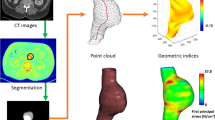Abstract
Although aneurysm size still remains the most accepted predictor of rupture risk, abdominal aortic aneurysms (AAAs) with maximum diameter smaller than 5 cm may also rupture. Growth rate is an additional marker for rupture risk as it potentially reflects an undesirable wall remodeling that leads to fast regional growth. Currently, an indication for surgery is an expansion rate >10 mm/year, measured as change in maximum diameter over time. However, as AAA expansion is non-uniform, it is questionable whether measurement of maximum diameter change over time can capture increased localized remodeling activity. A method for estimating AAA surface area growth is introduced, providing a better measure of local wall deformation. The proposed approach is based on the non-rigid iterative closest point algorithm. Optimization and validation is performed using 12 patient-specific AAA geometries artificially deformed to produce a target surface with known nodal displacements. Mesh density sensitivity, range of uncertainty, and method limitations are discussed. Application to ten AAA patient-specific follow-ups suggested that maximum diameter growth does not correlate strongly with the maximum surface growth (R 2 = 0.614), which is not always colocated with maximum diameter, or uniformly distributed. Surface growth quantification could reinforce the quality of aneurysm surveillance programs.






Similar content being viewed by others
References
Antiga L, Steinman DA (2004) Robust and objective decomposition and mapping of bifurcating vessels. IEEE Trans Med Imaging 23:704–713
Audenaert E (2013) Matlab Central. http://www.mathworks.com/matlabcentral/fileexchange/41396-nonrigidicp. Accessed Feb 2015
Baek S, Zambrano BA, Choi J, Lim C-Y Growth prediction of abdominal aortic aneurysms and its association of intraluminal thrombus. In: 11th World congress on computational mechanics, Barcelona, Spain, 20–25 July 2014
Besl PJ, Mckay ND (1992) A Method for Registration of 3-D Shapes. Ieee T Pattern Anal 14:239–256. doi:10.1109/34.121791
Darling RC, Messina CR, Brewster DC, Ottinger LW (1977) Ilizarov treatment of scaphoid nonunion. The case for early resection. Circulation 56:II161–II164
Dunn G (1993) Book review. Morphometric tools for landmark data: geometry and biology by Fred L. Bookstein, Cambridge University Press, Cambridge, 1991. Stat Med 12:714–715. doi:10.1002/bimj.4710350416
Erbel R, Aboyans V, Boileau C, Bossone E, Bartolomeo RD, Eggebrecht H, Evangelista A, Falk V, Frank H, Gaemperli O, Grabenwoger M, Haverich A, Iung B, Manolis AJ, Meijboom F, Nienaber CA, Roffi M, Rousseau H, Sechtem U, Sirnes PA, Allmen RS, Vrints CJ, Guidelines ESCCfP (2014) 2014 ESC Guidelines on the diagnosis and treatment of aortic diseases: document covering acute and chronic aortic diseases of the thoracic and abdominal aorta of the adult. The task force for the diagnosis and treatment of aortic diseases of the european society of cardiology (ESC). Eur Heart J 35:2873–2926. doi:10.1093/eurheartj/ehu281
Georgakarakos E, Ioannou CV, Papaharilaou Y, Kostas T, Katsamouris AN (2011) Computational evaluation of aortic aneurysm rupture risk: what have we learned so far? J Endovasc Ther 18:214–225. doi:10.1583/10-3244.1
Kendall DG (1989) A survey of the statistical theory of shape. Stat Sci 4:87–99
Kontopodis N, Metaxa E, Gionis M, Papaharilaou Y, Ioannou CV (2013) Discrepancies in determination of abdominal aortic aneurysms maximum diameter and growth rate, using axial and orthogonal computed tomography measurements. Eur J Radiol 82:1398–1403. doi:10.1016/j.ejrad.2013.04.031
Li H, Sumner RW, Pauly M (2008) Global correspondence optimization for non-rigid registration of depth scans. Comput Gr Forum 27:1421–1430. doi:10.1111/j.1467-8659.2008.01282.x
Martufi G, Auer M, Roy J, Swedenborg J, Sakalihasan N, Panuccio G, Gasser TC (2013) Multidimensional growth measurements of abdominal aortic aneurysms. J Vasc Surg 58:748–755. doi:10.1016/j.jvs.2012.11.070
Metaxa E, Kontopodis N, Tzirakis K, Ioannou CV, Papaharilaou Y (2015) Effect of intraluminal thrombus asymmetrical deposition on abdominal aortic aneurysm growth rate. J Endovasc Ther 22:406–412. doi:10.1177/1526602815584018
Metaxa E, Tremmel M, Natarajan SK, Xiang J, Paluch RA, Mandelbaum M, Siddiqui AH, Kolega J, Mocco J, Meng H (2010) Characterization of critical hemodynamics contributing to aneurysmal remodeling at the basilar terminus in a rabbit model. Stroke 41:1774–1782. doi:10.1161/STROKEAHA.110.585992
Metz CT, Klein S, Schaap M, van Walsum T, Niessen WJ (2011) Nonrigid registration of dynamic medical imaging data using nD + t B-splines and a groupwise optimization approach. Med Image Anal 15:238–249. doi:10.1016/j.media.2010.10.003
Moris DN, Georgopoulos SE (2013) Circulating biomarkers for abdominal aortic aneurysm: what did we learn in the last decade? Int Angiol J Int Union Angiol 32:266–280
Niculescu G, Nosher JL, Schneider MD, Foran DJ (2009) A deformable model for tracking tumors across consecutive imaging studies. Int J Comput Assist Radiol Surg 4:337–347. doi:10.1007/s11548-009-0298-x
Raut SS, Chandra S, Shum J, Finol EA (2013) The role of geometric and biomechanical factors in abdominal aortic aneurysm rupture risk assessment. Ann Biomed Eng 41:1459–1477. doi:10.1007/s10439-013-0786-6
Satriano A, Rivolo S, Martufi G, Finol EA, Di Martino ES (2015) In vivo strain assessment of the abdominal aortic aneurysm. J Biomech 48:354–360. doi:10.1016/j.jbiomech.2014.11.016
Sotiras A, Davatzikos C, Paragios N (2013) Deformable medical image registration: a survey. IEEE Trans Med Imaging 32:1153–1190. doi:10.1109/Tmi.2013.2265603
Vlachopoulos G, Korfiatis P, Skiadopoulos S, Kazantzi A, Kalogeropoulou C, Pratikakis I, Costaridou L (2015) Selecting registration schemes in case of interstitial lung disease follow-up in CT. Med Phys 42:4511–4525. doi:10.1118/1.4923170
Acknowledgements
The authors would like to thank Dr. Emmanuel Audenaert, MD, Ph.D., at Ghent University for useful discussions on the ICP algorithm and his advice and suggestions for its adaptation. The work was financially supported in part by the Action “Supporting Postdoctoral Researchers”, co-financed by the European Social Fund (ESF) and the Greek State (LS7_2224). Additionally, it was supported in part by the European Commission (EC) via the European Regional Development Fund and the General Secretariat for Research and Technology (GSRT) of the Hellenic Ministry of Education via the BIOSYS Research Project, Action KRIPIS, Project No. MIS-448301 (2013SE01380036).
Author information
Authors and Affiliations
Corresponding author
Ethics declarations
Conflict of interests
The authors declare that they have no conflict of interest.
Human rights
For this type of study, formal consent is not required.
Rights and permissions
About this article
Cite this article
Metaxa, E., Iordanov, I., Maravelakis, E. et al. A novel approach for local abdominal aortic aneurysm growth quantification. Med Biol Eng Comput 55, 1277–1286 (2017). https://doi.org/10.1007/s11517-016-1592-8
Received:
Accepted:
Published:
Issue Date:
DOI: https://doi.org/10.1007/s11517-016-1592-8




